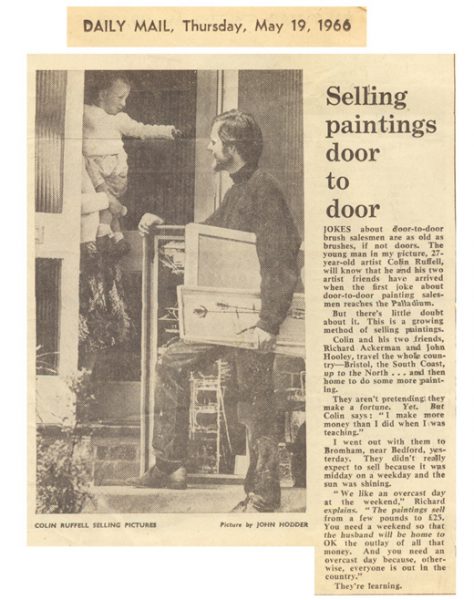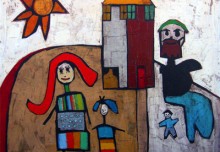DOOR TO DOOR selling art in the 1960’s
DOOR TO DOOR was my way of selling art in the 1960’s. It was an unusual method for artists to make a living. It even got a mention in the Daily Mail. Here is the cutting. The paper contacted me and sent a photographer up to Bedford to take the photo. Goodness knows how the press heard about this. I guess someone must have thought it interesting enough to be worth a few column inches.

Daily Mail cutting from 1966
I set this operation up with my old mates Richard Akerman, John Hooley, and Colin See-Paynton. We created a workshop and studio in the centre of Bedford, and set out every weekend to sell our artwork door to door.
The way that we did it was as follows.
- Paint and frame pictures during the week.
- Pack the new paintings into two vans on Friday and set off in pairs.
- Arrive in a new town and find bed and breakfast.
- Explore the town to find new housing estate if possible.
- Saturday, mid-morning start knocking on doors.
- Make appointments to return Saturday afternoon or Sunday.
- Go to appointments allowing one hour each.
- Take in 10 – 20 paintings and arrange around living room.
- Hold up paintings onto wall showing effect.
- Sell and get out.
- Meet in studio on Monday morning and compare notes.
- Go to bank and deposit cash and cheques.
We tried to get into 5 or 6 houses each during the weekend. After we got in our success rate was about 80 – 90% of viewers actually buying something. It worked! We survived as full time artists. We were young and fit so we had the stamina needed to be able to do it. Walking and door knocking was good exercise.
Good and bad.
The first downside was that we worked every weekend. All weekend, arriving back home late Sunday evening. That is bad for family life.
Secondly, we were affected by weather. Nobody welcomed a soaking wet stranger on the doorstep. So some weeks were barren. That is bad for the bank balance.
But on the other hand the list of upsides might come as a surprise.
Firstly, the constant regular critical feedback from our viewers really helped us make better art. The potential art collectors were in the comfort zone of their own homes. They gave us valuable, first-hand, positive, and negative reaction to our art. We discovered that when artists keeps exposing themselves to the audience then they will find out if their art is working. And why.
Secondly, even on a good day we were only welcomed into about one house in ten. The nine ‘no thank you’ responses could be ticked off quickly. We were surprised and happy to discover that 90% rejection didn’t matter, doesn’t hurt, and could be seen as a way forward.
Thirdly, and most importantly, as we learned what people wanted, we learned how to sell, and how to satisfy their needs with our paintings.
Fourthly, we found out that artists are not entitled to a living, instead they have to earn it. And they can. We realized that we were a business, and there was no need for us to re-invent the wheel, so we gradually adopted existing business strategies.
Later.
After a year or so we hankered after a more established and family friendly path. Richard Akerman was approached by a major publisher and became the second best print selling artist of all time after Monet. I lost touch with John. Colin See-Paynton and I joined forces by doing trade shows and putting on live demonstrations of our painting styles to supply furniture shops and interior designers with our art. Colin went on from that and has become a very respected senior figure in wood engraving circles. Me? Oh that’s another story.
Conclusion.
The four positive lessons that we adopted have lasted through my whole career as a full time professional artist. Long after moving on from door-to-door selling, the same four principals apply.
- Welcome first hand feedback. Artists make art for other people to look at and enjoy. Do not be satisfied with situations where the only feedback is second hand through middle-men or dealers.
- Most people will reject your art. Don’t be put off by this fact because there are some others who will love it. Just keep going until you meet them.
- Selling is a process that really does happen when you provide what the customer wants.
- Business is a worthy and necessary part of human life. Artists and art products are not immune to established commercial principals. In fact artists should embrace the fact that they are part of the business society.
Onward and upward.
***LATEST NEWS***
Here at ArtPublish.com we have set up a couple of new groups.
The first group is for Art Lovers and Art Collectors who are interested in our art-work. For members of the group we will be offering discounts, special previews, advance news about exhibitions and new releases, private view invitations, and other things.
The second group is aimed at fine-art professionals. The members are artists, art dealers, publishers, galleries, art teachers, and art investors. Here we share our own 150 years experience as full-time fine-art professionals, and invite others to join in discussions, etc.
And of course some of our readers want to be in both groups.
This is how you can join either group, or both groups.
Please click on the link below that suits you best for more info
C. “I am interested in both please send me all the information.”




